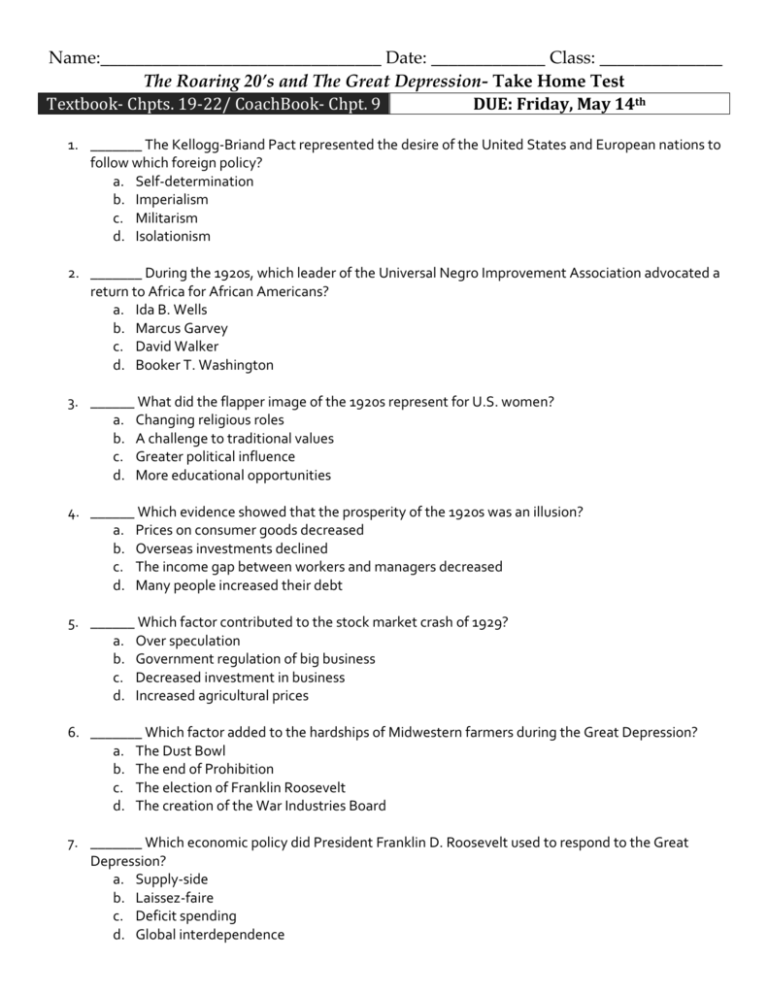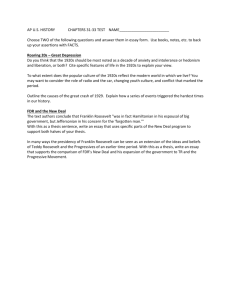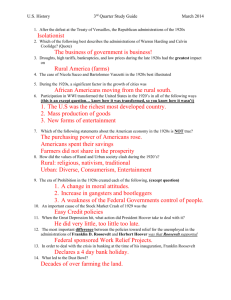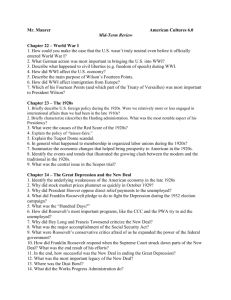Take Home Test
advertisement

Name:________________________________ Date: _____________ Class: ______________ The Roaring 20’s and The Great Depression- Take Home Test Textbook- Chpts. 19-22/ CoachBook- Chpt. 9 DUE: Friday, May 14th 1. _______ The Kellogg-Briand Pact represented the desire of the United States and European nations to follow which foreign policy? a. Self-determination b. Imperialism c. Militarism d. Isolationism 2. _______ During the 1920s, which leader of the Universal Negro Improvement Association advocated a return to Africa for African Americans? a. Ida B. Wells b. Marcus Garvey c. David Walker d. Booker T. Washington 3. ______ What did the flapper image of the 1920s represent for U.S. women? a. Changing religious roles b. A challenge to traditional values c. Greater political influence d. More educational opportunities 4. ______ Which evidence showed that the prosperity of the 1920s was an illusion? a. Prices on consumer goods decreased b. Overseas investments declined c. The income gap between workers and managers decreased d. Many people increased their debt 5. ______ Which factor contributed to the stock market crash of 1929? a. Over speculation b. Government regulation of big business c. Decreased investment in business d. Increased agricultural prices 6. _______ Which factor added to the hardships of Midwestern farmers during the Great Depression? a. The Dust Bowl b. The end of Prohibition c. The election of Franklin Roosevelt d. The creation of the War Industries Board 7. _______ Which economic policy did President Franklin D. Roosevelt used to respond to the Great Depression? a. Supply-side b. Laissez-faire c. Deficit spending d. Global interdependence 8. ________ After the U.S. Supreme Court ruled that several New Deal programs were unconstitutional, how did President Franklin Roosevelt try to influence future decisions of the Court? a. By asking important congressmen to start impeachment charges against several court justices b. By appointing a new chief to the Supreme Court c. By paying bribes to several justices d. By trying to increase the number of Supreme Court justices 9. _________ The Harlem Renaissance refers to?: a. the movement of African-American artists, poets, and writers who expressed their pride in being black. b. the "Lost Generation" of writers who moved to Europe during the 1920s. c. the most famous jazz ensemble during the 1920s. d. the name of the shipping company owned by the United Negro Improvement Association, promoting a "Back-To-Africa" movement. 10. _________In order to deal with the crisis in banking at the time of his inauguration, Franklin Roosevelt?: a. declared a four-day "banking holiday" and prohibited the export of money. b. urged Congress to pass legislation banning fractional reserve banking and holding bank trustees responsible for all deposits. c. announced a multi-billion dollar federal bailout package. d. announced the nationalization of all banks with over $100 million in total assets. 11. _______ Which of the following was NOT one of the 3 R’s in FDR’s New Deal? a. Reform b. Recovery c. Reasoning d. Relief 12. _______ Why did the Hawley-Smoot Tariff (1930) fail? a. U.S. producers made too much money b. Other countries stopped buying American goods c. Italy and Germany had booming economies d. American’s refused to trade with other countries 13. ________ In the 1920s companies used “welfare capitalism” to encourage workers to a. be satisfied without pensions or fringe benefits. b. buy stock and invest in their companies. c. reject unions and accept lower wages. d. register with mainstream political parties. 14. ________ The Teapot Dome scandal concerned Secretary of the Interior Albert Fall’s willingness to a. a. pay oil companies secretly to drill on privately owned land. b. b. allow Britain to avoid tariffs on imported teas. c. c. accept bribes to allow oil companies to drill on federally owned land. d. d. lobby legislators to limit the amount of land set aside for nature preserves. 15. _______The direct goal of most of President Calvin Coolidge’s policies was a. promoting the expansion of the government’s role in the arts and sciences. b. limiting government and supporting business. c. promoting the visibility of non-profit organizations and charities. d. aiding congressional plans to help American farmers. 16. _____When African American soldiers returned from serving in World War I, they found a. a shortage of jobs. b. decreased racial tension in cities across the country. c. widespread respect for their service in the military. d. that the population was shifting from urban centers to more peaceful farmlands. 17. ______The Ku Klux Klan grew dramatically in the 1920s as many new members a. such as urban Catholics joined to protect themselves against immigrant gangs. b. from rural areas joined in hope of preserving their place in society as the influence of urban America grew. c. embraced the changes taking place in the cities. d. who were recent immigrants joined to protest work conditions in the South. 18. ______The Scopes trial pitted academic freedom and the teachings of modern science against a. the theory of evolution. b. the views of Marcus Garvey. c. the healing techniques of Aimee Semple McPherson. d. fundamentalism. 19. ______The primary goal of the NAACP was to a. improve safety conditions for African Americans who worked on assembly lines. b. end discrimination against and mistreatment of African Americans throughout the United States. c. end illiteracy among the nation’s poor, by focusing especially on those in rural areas. d. encourage African Americans to pursue jobs in the arts and sciences. 20. _____ In the 1920s distribution of illegal liquor became a. the main source of funding for the Ku Klux Klan. b. a widespread response to passage of the Twentieth Amendment. c. a key source of employment for those who took part in the Great Migration. d. the foundation of vast and wealthy criminal empires. 21. ______ Why was buying on margin riskier than other ways of investing in the stock market? a. If the stock price dropped, the investor might make only a small profit. b. If the stock price dropped, brokers could force investors to repay their loans. c. Margin calls forced investors to buy more stock. d. The Federal Reserve made it more difficult for brokers to lend to investors. 22. _____ In 1932 most families who lost jobs a. depended on federal programs for food. b. took new jobs in soup kitchens. c. begged, became hoboes, or went without food. d. lived on annuities from wealthier relatives. 23. _____ Why did the Smoot-Hawley Tariff Act backfire? a. Farmers were the only group that benefited from it. b. The tariff rates were too low. c. European nations responded with tariffs of their own. d. Only manufacturers derived benefits from the tariff. 24. _____Which of the following most clearly signaled economic weakness in the 1920s? a. uneven distribution of wealth b. good times in coal mining and other outdated industries c. the tremendous number of shares being traded on the stock exchange d. purchase of factory goods by families of average income 25. _______What was one basic purpose shared by the Emergency Banking Act, the Glass- Steagal Act, and President Roosevelt's fireside chats? a. to heighten Americans’ awareness of economic threats b. to promote a sense of pride in American banking c. to educate the public about economic theories d. to increase the public’s confidence 26. ______How did President Roosevelt’s philosophy differ from Herbert Hoover’s? a. Roosevelt believed it was acceptable for government to provide direct aid to people in times of crisis. b. Roosevelt played on the public’s fears. c. Roosevelt believed in minimal government interference in business. d. Roosevelt believed in “rugged individualism.” 27. ______In 1935 which government body struck significant blows to the New Deal’s attempts to bring change to the economy? a. the Senate b. House of Representatives c. the AFL d. the Supreme Court 28. ______In 1937 what misstep caused President Roosevelt to lose the support of some people within his own party and many people in the general public? a. his reliance on his wife to go places where he could not go because of his health b. his attempt to pack the Supreme Court with judges friendly to his policies c. his informal manner during his fireside chats d. his creation of the WPA FILL IN THE BLANK Read each sentence and fill in the blank with the word or phrase in the word pair that best completes the sentence. (2pts each) 1. The thriving economy of the 1920s especially benefited ______________________. (farmers/advertisers) 2. At the Washington Naval Conference the major naval powers agreed to _____________________ the size of their navies. (reduce/increase) 3. Speakeasies were a way that many Americans got around the restrictions that resulted from ___________. (Evolution/Prohibition) 4. _________________ was the unofficial capital of African American culture in the 1920s. (Harlem/Detroit) 5. A key slogan for members of the UNIA was _________________________. (“No justice, no peace!” /“Back to Africa!”) 6. In a decade full of firsts, the first woman to fly across the Atlantic was __________________________. (Edith Wharton/Amelia Earhart) 7. A key leader in the formation of the NAACP was ___________________. (W.E.B. Du Bois/Marcus Garvey) 8. The _______________________ is the total value of all goods and services produced in a nation. (margin of growth/gross national product) 9. “Black Tuesday” referred to the collapse of the _______________________. (stock market/bonus army) 10. Sprawling neighborhoods where people lived in rickety shacks were known as _______________________. (Hawleyvilles/Hoovervilles) 11. If stock prices dropped, brokers could force investors to repay their loans, if the investors were _______________________. (buying on margin/installment buying) 12. The _______________________ was created by private business and the federal government working together. (Federal Reserve/Hoover Dam) 13. The Civilian Conservation Corps was formed to solve the problem of young men having difficulty getting a/an ______________________. (job/education) 14. A centerpiece of the Second New Deal was the ________________________. (National Industrial Recovery Act/Social Security Act) 15. The _______________________ sought to transform an entire region of the country by building dams and other projects along a major river in the southeastern United States. (TVA/WPA) 16. Among the gains that labor made in the 1930s was the right to ____________________________. (collective bargaining/company-sponsored unions) TRUE/FALSE Indicate whether each statement below is true or false by writing T or F in the space provided. (1pt each) _____ 1. Most rural women in America approved of flappers. _____ 2. The guilt of John Scopes was never really in doubt during his trial. _____ 3. During Prohibition, liquor smuggling was big business in Detroit, Michigan, which was located just across the border from Canada. _____ 4. Racial violence erupted in a number of cities in the northern part of the United States after World War I. _____ 5. Hoover’s belief in “rugged individualism” meant that individuals needed help from the government to survive. _____ 6. The 1920s were good times for farmers and organized labor. _____ 7. After the stock market crashed, consumers spent money only on essentials. _____ 8. Careless agricultural practices contributed to the creation of the Dust Bowl. _____ 9. Foreclosures occur when lenders take over ownership of a property from an owner who has failed to make loan payments. _____ 10. The General Motors Strike in Flint, Michigan, that began in December 1936 ended in an enormous victory for the automaker. _____ 11. In the 1936 presidential election, the Republican candidate, Alf Landon, carried only two states, while Franklin Delano Roosevelt carried the rest. _____ 12. In the 1932 presidential election, Franklin Delano Roosevelt’s margin of victory over Hoover was slim.









